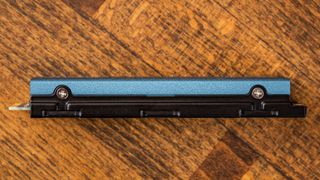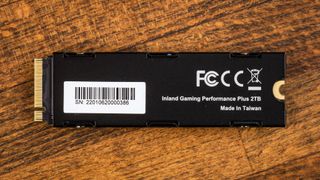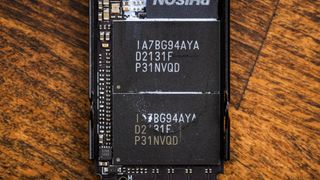Tom’s Hardware is supported by its audience. When you purchase through links on our site, we may earn an affiliate commission. Learn more
By published
Although the Gaming Performance Plus 2TB does nothing new, it does deliver in every important department with good performance, simple looks, it runs cool and efficient, and it all comes with a six-year warranty and brick and mortar availability.
Although the Gaming Performance Plus 2TB does nothing new, it does deliver in every important department with good performance, simple looks, it runs cool and efficient, and it all comes with a six-year warranty and brick and mortar availability.
+ Excellent performance
+ Strong warranty period
+ Convenience/availability
+ PS5 compatibility
+ Runs cool and efficient with an understated heatsink
+ Balanced cache design
– No software
The Inland Gaming Performance Plus is rated for up to 7.0 GBps of bandwidth, peaking at 700,000 IOPS over the PCIe 4.0 interface. This matches many other drives based on the Phison E18 SSD controller, including Inland’s regular Performance Plus that we reviewed previously. The new Gaming Performance Plus drive is ostensibly oriented at gaming and is specifically marketed as compatible with the Playstation 5 (PS5).
We also recently reviewed the Inland Prime, an entry-level drive with a surprisingly decent six-year warranty. In fact, the Inland Gaming Performance Plus is also supported for six years, which is a bit more than the typical five. Warrantied writes are nothing special at 700TBW per TB of capacity, though.
Inland is best known as Micro Center’s house brand for solid state drives (SSDs), offering convenience for builders lucky enough to live near one of the company’s brick and mortar (B&M) locations. The availability of the drives is a big selling point, especially as returns can go through the store. While the Inland drives don’t really offer anything special over other third-party manufacturers, the consistency of the lineup (segmented with different “P” models) means there’s a drive for everyone.
Any SSD will be a big improvement over a hard drive (HDD) when it loads a game, but beyond that, there’s usually not a huge difference between entry-level SATA and high-end PCIe SSDs. There’s enough difference to attract enthusiasts, of course, but the real path lies ahead: DirectStorage will, in time, make NVMe drives a more exciting prospect for gaming PCs. In the meantime, drives like this are good for upgrading a PS5, although the difference between drives in that console is often not very pronounced as long as they work.
We, of course, have seen a lot of Phison E18-based drives, including with Micron’s new 176-layer TLC (B47R) flash, so there’s nothing new o the hardware front here. The heatsink on the Gaming Performance Plus is a nice touch, but we’ll see if Inland has any other tricks up its sleeve.
The Gaming Performance Plus is rated for sequential speeds of up to 7.0/6.85 GBps read/write and up to 650,000/700,000 random read/write IOPS. Unfortunately, it’s available only at 1TB and 2TB. Current Micro Center (MC) pricing pegs it at around $0.14 per gigabyte, being a bit higher right now if purchased outside of an MC. This is a bit high compared to SSDs you’ll find on sale and even some competing products – see our upcoming XS70 review – but is below the obnoxiously premium prices we sometimes see in this space. It’s difficult for a drive of this caliber to hit its stride at just 500/512GB, and 4TB drives with TLC are still expensive or difficult to get, so the omission of these capacities is not surprising.
The SSDs’ IOPS are notably lower than other E18 drives, particularly models using 176-layer flash, but in practice, this is not super relevant for a consumer drive. Plus, those limitations may not be accurate, given that specifications for other Inland drives have been wrong in the past.
There’s nothing too exciting here, although one must appreciate that SSDs are now ubiquitous enough to allow premium models from a store brand.
Inland drives are known for minimal fluff; there’s not too much in the way of software. They tend to be based on Phison SSD controllers, and, therefore, it is sometimes possible to find universal or generic firmware updates. That being said, firmware updates should rarely be needed.
Other features, such as monitoring health, cloning, et cetera, can be managed with free software packages like CrystalDiskInfo (CDI) and Macrium Reflect Free. Inland may want to minimize its support structure, which makes sense, but there is an opportunity for the company to stand out in the future if it so desires.




Beneath the heatsink, we can quickly spot the controller, DRAM cache, and four NAND packages on the top side, all on a dark PCB. The physical layout is slightly different from what is seen on the Fury Renegade, which has Kingston’s dual DRAM package configuration.
The typical ratio of DRAM to NAND is 1GB of DRAM per 1TB of NAND, which facilitates the typical 4KB logical page addressing. Still, the precise amount required varies based on many things such as workload, mapping type, compression technology, etc. Consumer usage tends to not need nearly that much DRAM for this much capacity, but it’s nice to see on a premium drive.
The flash on this drive runs at a 1200 MT/s (megatransfers per second) I/O speed, translating to 1200 MBps as the flash operates in an 8-bit transfer mode. The flash and bus transfer more than just data — they also carry commands, so a higher I/O speed can help speed multiple functions, thus providing lower latency and higher performance. We saw this when comparing the Kingston KC2500 and KC2000.
The Gaming Performance Plus does not do anything risky here and instead opts for a proven configuration.
MORE: Best SSDs
MORE: How We Test HDDs And SSDs
MORE: All SSD Content
Current page: Features and Specifications
Shane Downing is a Freelance Reviewer for Tom’s Hardware US, covering consumer storage hardware.
Get instant access to breaking news, in-depth reviews and helpful tips.
Thank you for signing up to Tom’s Hardware. You will receive a verification email shortly.
There was a problem. Please refresh the page and try again.
Tom’s Hardware is part of Future US Inc, an international media group and leading digital publisher. Visit our corporate site.
© Future US, Inc. Full 7th Floor, 130 West 42nd Street, New York, NY 10036.









